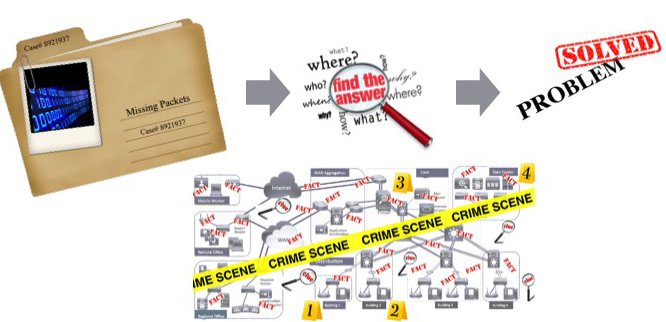T-25 days until Chrome starts flagging HTTP sites as “Not Secure”

Less than one month from today, on July 23, Google will start prominently labeling any site loaded in Chrome without HTTPS as "Not Secure".
When we wrote about Google’s plans back in February, the percent of sites loaded over HTTPS clocked in at 69.7%. Just one year prior to that only 52.5% of sites were loaded using SSL/TLS—the encryption protocol behind HTTPS—so tremendous progress has been made.
Unfortunately, quite a few Continue reading
Data Center Tech ‘Graduation’: What IT Pros Have Learned
What new technologies have IT pros deployed and experimented with this year? SolarWinds finds out what tech its THWACK community members have tried out in 2018.
Techniques of a Network Detective: A New Series
Put your detective hat on your head and your Network Detective badge on your lapel. Introducing a new blog series – Techniques of a Network Detective. This series will focus on the detective work (troubleshooting side) of our jobs as network engineers.
For over 30 years I’ve been playing in the “world of IT”. During those years there have been a lot of changes in our world. But through all that change, there has been a thread, for me, that has always remained constant. A thread and a passion that always seemed to be with me in every job over all these years.
Troubleshooting!
Being a “Network Detective” is much the same as being a regular detective in many ways. As a Network Detective we get put on a “case” – the “Case of the Missing Packets” maybe. We go to the crime scene and try to find answers so we can solve the “who done it”
When a “crime” happens you need to be right there interviewing the suspects, surveying the crime scene, asking the right questions. Trying to quickly figure out what is happening, where it is happening, and why it Continue reading
Network Infrastructure as Code in Network Automation Online Course
In mid-May, I ran an onsite network automation workshop, and the manager organizing the workshop for his team invited me to a dinner with his peers. Not surprisingly, they wanted to hear about the topics covered in the workshop, and as soon as I mentioned Network-Infrastructure-as-Code several of them said “yes, that definitely needs to be covered.”
Read more ...Qualcomm’s Edge Platform Will Upgrade IoT Modules
 Companies can deploy 2G IoT modules today and upgrade them to NB-IoT or CAT-M when network coverage is more comprehensive.
Companies can deploy 2G IoT modules today and upgrade them to NB-IoT or CAT-M when network coverage is more comprehensive.
Packet Size, It Matters
As I mentioned in a previous post, I have been studying the materials for the Cisco CCDE. One thing that has come up only a time or two is that of MTU. MTU, or maximum transmission unit, is the maximum size a chunk of data can be for a given interface. In this article, we are speaking specifically of IP MTU and this is an important distinction that I will clarify later. Network design should incorporate a clear understanding of MTU challenges and operators need to understand what to look for when it is not properly built and configured.
A simplistic example of a problematic design is when there is a link with a smaller MTU somewhere between two endpoints capable of creating larger packets (see the image below). While this environment may work fine, understanding the interaction required between the hosts and the network devices is very important to network design.

A few years ago I wrote an article that outlined some of the behavior that can be witnessed when there are MTU discovery issues. Let’s quickly recount what path MTU discovery (PMTU-D) is, how it works, how it fails and some logic around appropriate design.
General Facts Around Continue reading
Pain in the XaaS: Rise of FaaS, CaaS Adds to Cloud Orchestration Woes
 The latest cloud orchestration report indicates that CIOs, cloud architects, and other IT infrastructure managers need to educate themselves on an increasingly wide variety of options.
The latest cloud orchestration report indicates that CIOs, cloud architects, and other IT infrastructure managers need to educate themselves on an increasingly wide variety of options.
Deutsche Telekom Demonstrates 5G Network Architecture With Third-Party VNFs
 DT deployed a network data layer using HPE’s shared data environment. The shared layering helps the network handle a large variety of workloads while maintaining agility.
DT deployed a network data layer using HPE’s shared data environment. The shared layering helps the network handle a large variety of workloads while maintaining agility.
GitLab Ditches Microsoft Azure for Google Cloud, Kubernetes
 The move is tied to the company’s desire to further exploit Google's Kubernetes support. Although the timing is interesting given Microsoft's recent announcement that it is purchasing GitHub.
The move is tied to the company’s desire to further exploit Google's Kubernetes support. Although the timing is interesting given Microsoft's recent announcement that it is purchasing GitHub.
Google Becomes Platinum Member of The Linux Foundation
 Sarah Novotny, the head of open source strategy for Google Cloud Platform, will join The Linux Foundation board of directors.
Sarah Novotny, the head of open source strategy for Google Cloud Platform, will join The Linux Foundation board of directors.
Dell, VMware Still Dominate HCI Charts, Says IDC
 For the second quarter in a row Dell Technologies’ brands ranked No. 1 in hyperconverged hardware and software sales.
For the second quarter in a row Dell Technologies’ brands ranked No. 1 in hyperconverged hardware and software sales.
FOX Networks Trials Barefoot Networks’ Tofino Programmable Chip
 Broadcast networks are increasingly moving to IP, and this gives them the opportunity to take advantage of a programmable forwarding plane.
Broadcast networks are increasingly moving to IP, and this gives them the opportunity to take advantage of a programmable forwarding plane.

